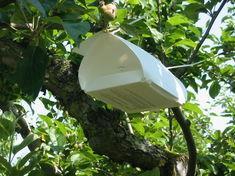
Mating disruption, as a technique, has been used in continental Europe, South Africa, Australia and the US, but it has not been used in the UK until now due to regulatory barriers. The system relies on tags or lures, impregnated with pheromone and placed in the field in large numbers to create a cloud of pheromone and hence prevent the male moths from detecting females.
Exosect’s assistant sales manager Georgina Kemp says: “Traditional systems have not available in the UK because pheromones are classified under directive 91/414 - in the same league as chemical pesticides, which, whilst being a little foolish (since they are naturally derived and less toxic than table salt) means that products for insect control using pheromones must undergo the same data provisions as a registration package for a chemical pesticide. This is hugely expensive and the UK market is simply not big enough to justify a sustainable business case.”
The barriers to entry are particularly pertinent for major multinational suppliers of pheromone-based products. However, Exosect is a British company and saw the benefit of developing a product for its home market - the success of which it hopes will allow it to dominate a niche in the UK and enhance marketability of Exosex overseas.
“Working under a pilot scheme with the Pesticide Safety Directive (PSD), we registered Exosex via a fast-track scheme,” says Kemp, “and one of the reasons why we were accepted through this route is that the quantity of pheromone we are using is small in comparison to other systems. PSD took a very pragmatic view on the product, accepting data waivers for many of the issues that would usually require major expenditure to generate. So, we are very proud that this is the first mating disruption system in the UK.”
The system needs to be in place before the first moth emergence. It works well on low to medium infestation levels but with very high infestation all mating disruption systems are usually overwhelmed. If an orchard had a very high infestation the previous year, Exosect recommends that the first generation should be knocked down with a spray before putting Exosex in place.
Traditional pheromone is costly and the techniques are not cheap. They also require enough manpower to place 300 to 1,000 tags per hectare. The Exosex CM system, however requires only 25-30 dispensers per hectare and uses greatly reduced quantities of pheromone - nearly 1,000 times less than some of the systems used overseas. Rather than a cloud of pheromones engulfing the orchards, Exosex also releases just [an approximated] 87.5mg of pheromones per hectare. “For the UK market, this last fact is vital,” says Kemp. “The amount of pheromones released into the atmosphere by Exosex is roughly equivalent to the background level during a heavy infestation.
“The product is not a silver bullet and must be supplemented with sprays when monitoring trap counts are high. The intention is to create a situation in which the overall number of sprays applied to the crop for Codling Moth control is reduced - with the consequent effect of lower pesticide residues on the fruit at harvest.”
Exosex is being distributed through Hutchinsons. It is still too early for Exosect to talk results in the first commercial season for Exosex CM in the UK, but Kemp says that work on both trial and commercial crops has progressed as planned. Results will be available after harvest, in late October or November.
“We are carrying out some trials this year alongside commercial sales. We have two trials in Kent, one in Herefordshire and one in Gloucestershire,” she says. “We are in close contact with growers and other parts of the supply chain and to date we’re confident that it’s been going quite well. It is always difficult to gauge the first season of any new product, particularly one that is relatively unknown in the market. We expect the scale of use of the product increase next year as word of mouth gets around and the concept of mating disruption is better understood by the UK growers and we think the product will do as well and probably better with experience.”
Exosex is at different stages of securing regulatory approval in the US, South Africa and other European markets. Kemp says: “This is a very positive development for the UK market and for us, we have been able to use it as a test market before we look at larger markets.”
EXOSECT: THE BACKGROUND
Exosect Limited was formed in 2001 to commercialise pest control technology developed by Professor Philip Howse OBE during his 30 years at the University of Southampton’s School of Biological Sciences. Howse remains as Exosect’s technical director.
Focusing primarily on research and development, Exosect has developed a range of delivery systems based on the concept of electrostatic and bio-magnetic attraction. Specialising in environmentally acceptable pest control products, markets include crop protection (agriculture and horticulture), forestry and amenity landscape, public health, animal health and the consumer sectors. It is a member of the Commercial Horticultural Association and many products have been awarded organic standards certification by Organic Farmers & Growers Ltd. More at www.exosect.com